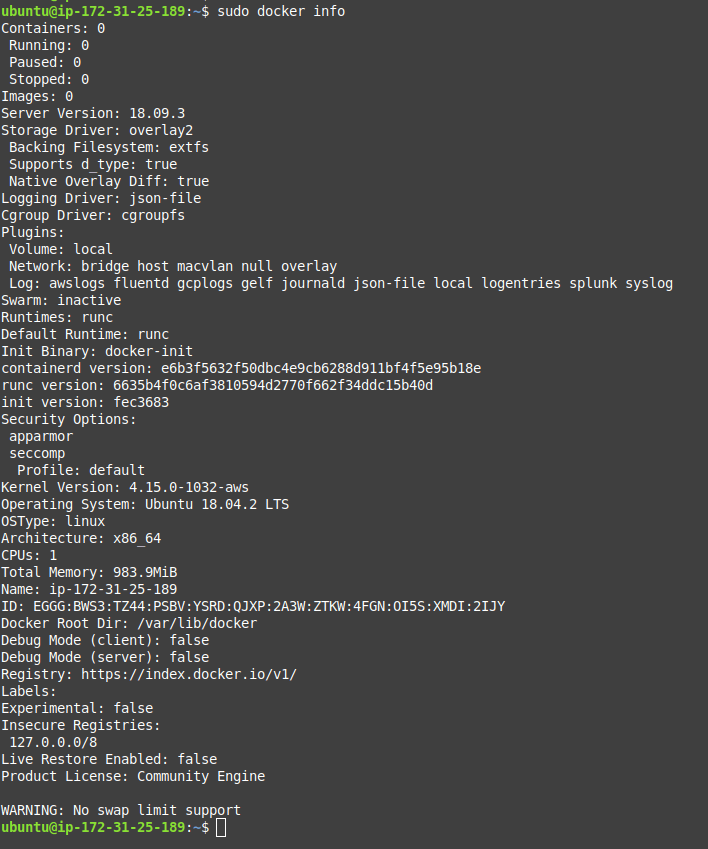Amazon Install Docker
Amazon Linux provides a stable, secure, and high-performance execution environment for applications. Amazon Elastic Container Registry integrates with Amazon EKS, Amazon ECS, AWS Lambda, and the Docker CLI, allowing you to simplify your development and production workflows. You can easily push your container images to Amazon ECR using the Docker CLI from your development machine, and integrated AWS services can pull them directly for. Once you have installed the credential helper, see the Configuration section for instructions on how to configure Docker to work with the helper. To build and install the Amazon ECR Docker Credential Helper, we suggest Go 1.12+, git and make installed on your system. Docker Desktop includes Docker Engine, the Docker CLI client, Docker Compose, and other tools that are helpful when using Docker with Amazon ECS. For more information about how to install Docker Desktop on your preferred operating system, see Docker Desktop overview.
Share and deploy container software, publicly or privately
Amazon Elastic Container Registry (ECR) is a fully managed container registry that makes it easy to store, manage, share, and deploy your container images and artifacts anywhere. Amazon ECR eliminates the need to operate your own container repositories or worry about scaling the underlying infrastructure. Amazon ECR hosts your images in a highly available and high-performance architecture, allowing you to reliably deploy images for your container applications. You can share container software privately within your organization or publicly worldwide for anyone to discover and download. For example, developers can search the ECR public gallery for an operating system image that is geo-replicated for high availability and faster downloads. Amazon ECR works with Amazon Elastic Kubernetes Service (EKS), Amazon Elastic Container Service (ECS), and AWS Lambda, simplifying your development to production workflow, and AWS Fargate for one-click deployments. Or you can use ECR with your own containers environment. Integration with AWS Identity and Access Management (IAM) provides resource-level control of each repository. With ECR, there are no upfront fees or commitments. You pay only for the amount of data you store in your repositories and data transferred to the Internet.
Benefits
Reduce your effort with a fully managed registry
Amazon Elastic Container Registry eliminates the need to operate and scale the infrastructure required to power your container registry. There is no software to install and manage or infrastructure to scale. Just push your container images to Amazon ECR and pull the images using any container management tool when you need to deploy.
Amazon Linux 2 Install Docker-compose
Securely share and download container images
Amazon Elastic Container Registry transfers your container images over HTTPS and automatically encrypts your images at rest. You can configure policies to manage permissions and control access to your images using AWS Identity and Access Management (IAM) users and roles without having to manage credentials directly on your EC2 instances.
Provide fast and highly available access
Amazon Elastic Container Registry has a highly scalable, redundant, and durable architecture. Your container images are highly available and accessible, allowing you to reliably deploy new containers for your applications. You can reliably distribute public container images as well as related files such as helm charts and policy configurations for use by any developer. ECR automatically replicates container software to multiple AWS Regions to reduce download times and improve availability.
Simplify your deployment workflow
Amazon Elastic Container Registry integrates with Amazon EKS, Amazon ECS, AWS Lambda, and the Docker CLI, allowing you to simplify your development and production workflows. You can easily push your container images to Amazon ECR using the Docker CLI from your development machine, and integrated AWS services can pull them directly for production deployments. Publishing container software is as easy as a single command from CI/CD workflows used in the software developer process.
How it works
'At Pinterest we use Amazon Elastic Container Registry (ECR) for managing our Docker container images. We use ECR’s image scanning feature to help us improve security of our container images. ECR scans images for a broad range of operating system vulnerabilities and lets us build tools to act on the results.”

Cedric Staub, Engineering Manager, Pinterest
At Blackboard, our mission is to advance learning for students, educators and institutions around the globe. In order to best serve clients, we use ECR because it provides a stable and secure container registry for Blackboard to host first and third-party images. ECR provides the high availability and uptime other registries fail to maintain, while providing a fully managed solution that has streamlined our workflows at Blackboard.”
Joel Snook, Director, DevOps Engineering
“Snowflake decided to replicate images to ECR, a fully managed docker container registry, providing a reliable local registry to store images. Additional benefits for the local registry are that it’s not exclusive to Joshua; all platform components required for Snowflake clusters can be cached in the local ECR Registry. For additional security and performance Snowflake uses AWS PrivateLink to keep all network traffic from ECR to the workers nodes within the AWS network. It also resolved rate-limiting issues from pulling images from a public registry with unauthenticated requests, unblocking other cluster nodes from pulling critical images for operation.”
Brian Nutt, Senior Software Engineer, Snowflake
This tutorial explains, how to install docker on EC2 Instance. Before starting, let’s have some brief knowledge about Docker.
Docker is a platform that combines applications and its dependencies in the form of packages, called container. We can run multiple containers on a single Operating System. Containers are not Virtual Machines. Virtual Machines requires Operating System to run applications, but containers do not. As containers don’t need an Operating System, it takes very little time to start and hence it is very faster than Virtual Machines.
Also Learn: How to install Ansible on Amazon Linux(EC2 )
and Launching Amazon Linux EC2 Instance
Let’s Install Docker on EC2 Instance
In this tutorial, we will use Amazon Linux to install docker. Amazon Linux/Amazon Linux2 is the Linux Operating System used in EC2 Instance.
Step 1– Log to Linux EC2 Instance and update it.
$ sudo yum update -y
Step 2– Install docker using Yum command
$ sudo yum install docker -y
Step 3– Start Docker Service
$ Service docker start
Step 4– Check docker Version.
$ docker -v
Basic Configuration (Creating Docker File / Running Docker Image)
After you install docker on ec2 , let’s have some basic setup for Docker.
Step 1 – Create a docker file
Dockerfile is a text file where we write instructions to build an image.
Create a folder name Images on the Amazon Linux box.
$ mkdir images
Move to folder images
$ cd images
Create a file name Dockerfile inside images folder
$ nano Dockerfile

Put the content in the following way inside the Dockerfile.
FROM Ubuntu ( It will use the Official image Ubuntu to build your image)
MAINTAINER chandan <[email protected]>
( It sets the Author field of the generated image)
RUN apt-get update ( It will update the image at the time of Build)
CMD [ “echo”, ” Hello World ……….! “] ( It will run echo command when we run the docker container image)
Please also readHow to install docker on ec2 Instance(Windows)
You may also likeInstall Docker on Ubuntu using Script

Step 2– Run the docker build command to build the image.
$ docker build .
Note : ( . command is used when you are inside images folder where Dockerfile is present, alternatively you can put the docker file absolute path like /home/ec2-user/images/Dockerfile)
You can run the following command as well to Name and tag your Image. Here myimage is the Name and 01 is Tag of the image.
$ docker build -t myimage:01 .

Step 3– See the Docker Images after build
$ docker images
Step 4 – Run the docker image
$ docker run 07deaa33585e

Here 07deaa33585e is the IMAGE ID that can be seen in docker images command.
You can see here, it executed the echo command as soon as we run the docker image. In the same way, we can run any script, commands or any application by running a docker image.
Click to tweet this tip !
I hope you enjoyed this tutorial and learned to install docker on ec2 instance (Amazon Linux). If you think this is really helpful, please do share this with others as well. Please also share your valuable feedback, comment or any query in the comment box. I will really happy to resolve your all queries anytime.
Thank You
Amazon Linux 2 Install Docker
If you think we helped you or just want to support us, please consider these:-
Amazon Linux Ami Install Docker
Connect to us: Facebook | Twitter
